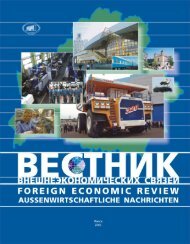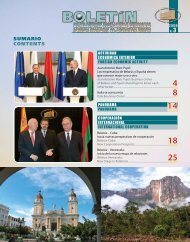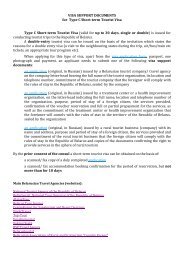More important thangetting prices right, adevelopmental statemust get policy prioritiesright. They shouldbe people-centred,promoting opportunitieswhile protecting againstdownside riskssuccess. After 1961, the governmentachieved a position of dominance over itsbusiness class through a series of reforms,including measures that increased the institutionalcoherence of the state, such as thecreation of the Economic Planning Board,but centred on control over finance. It alsoavoided the capture of state policies onsubsidies. Subsequently, it was able to guidea shift from import substitution to exportpromotion. 18Other rising countries of the South havepursued similar policies. Governments havepartnered with the private sector to developcomparative advantage in the most promisingsectors while ensuring effective macroeconomicmanagement and promoting innovation. Theyhave also paid special attention to expandingsocial opportunities by setting policy priorities,nurturing selected industries, fosteringstate-market complementarities, committing tolong-term reforms, having strong political leadership,learning by doing and boosting publicinvestment.Setting policy prioritiesMore important than getting prices right, adevelopmental state must get policy prioritiesright. They should be people-centred, promotingopportunities while protecting againstdownside risks. Getting policies and policypriorities right raises the equally importantissue of getting policymaking right. Governinginstitutions and policies are profoundly and inextricablylinked; one cannot succeed withoutthe other. It is thus important to have policyprocesses managed by committed people ineffective and responsive government structures.Policies also change at different stages of development:at early stages, for example, manycountries prioritize job creation and povertyreduction.• Indonesia. From the mid-1970s, supportedby revenues from newfound oilwealth, Indonesia complemented importsubstitutingindustrialization with a majorthrust in agriculture and rural development(see box 3.4 for the transformative potentialof strategic investments in agriculture).This strategy of balanced growth increasedthe demand for labour, thus reducing unemploymentand increasing real wages. 19Then in the mid-1980s, as oil incomebegan to decline, Indonesia shifted fromimport substitution to outward-orientedindustrialization, drawing in surplus labourfrom agriculture to work in manufacturing,which offered higher wages. By the early1990s, when the supply of surplus labourhad been exhausted, poverty reduction continuedprimarily through wage increases.BOX 3.3Akihiko Tanaka, President, Japan International Cooperation AgencyJapan and triangular cooperationBolstered by the remarkable economic performance of emerging countries,South–South cooperation and triangular cooperation have grown rapidly inrecent years. They have outgrown their traditional role as complements toNorth–South cooperation and are now an indispensable source of knowledgesharing and innovation for many developing countries.There are four virtues and merits of South–South and triangular cooperation:the benefits accrued from sharing knowledge and experience amongpeers to find more effective solutions; sharing appropriate technology andexperience that can promote convergence with North–South cooperationgoals; respecting real ownership, with the South in the driver’s seat; anddeveloping countries’ rapidly emerging as new donors.As early as 1975, Japan recognized the value of South–South andtriangular cooperation and began a large-scale triangular training programme.Japan had experienced a development trajectory similar to thatof some emerging countries today, having first been a net foreign aid recipientthen playing a dual role as aid recipient and emerging donor for anumber of years before finally becoming only a donor as the first Asianmember of the Organisation for Economic Co-operation and <strong>Development</strong>in 1964.This development pathway led Japan to believe that sharing developmentexperience, knowledge and appropriate technology among developingcountries can play a very useful role in development cooperation and thuswarranted donor support.A prime example is the cooperation among Brazil, Japan andMozambique. Japan helped Brazil develop its own tropical savannah region,known as the Cerrado, making it a leading producer of soybeans and otheragricultural products. The two countries now extend collaborative support toMozambique to develop that country’s vast savannah.An emerging challenge now is to scale up South–South and triangularcooperation as a central approach in development cooperation, while avoidingexcessive aid fragmentation among an increasing number of developmentactors.68 | HUMAN DEVELOPMENT REPORT <strong>2013</strong>
BOX 3.4Investing in agricultureStrategic investments in the agricultural sector can have transformativeeffects. Higher crop yields not only lead to improved livelihoods for farmers,they also increase demand for goods and services in rural areas, givingrise to new opportunities for economic development. They may also lead tolower food prices, reducing the share of food in household expenditures andcreating markets for other sectors of the economy.Agricultural research is a public good and tends to be underprovidedby the private sector. Consequently, governments can make usefulcontributions in this area. Recent studies on several African, Asianand Latin American countries show that increased public spending onagriculture is particularly good for promoting growth. Disaggregatingagricultural expenditure into research and nonresearch spending showsthat research spending is especially effective. Provision of other publicgoods, such as agricultural extension services and irrigation systems, isalso beneficial.China has the world’s largest agricultural research and developmentsystem in the world. Its research is based at the Chinese Academy ofAgricultural Sciences, universities and the Chinese Academy of Science,which together comprise of more than 1,100 research institutions. China isbecoming a leader in South–South cooperation with African countries, manyof which are now benefiting from its research.Agricultural technology has also been a strength of Brazil, where anestimated 41% of 2006 agricultural research spending in Latin America occurred.The System for Agricultural Research and Innovation has contributedgreatly to the nearly fourfold growth in agricultural efficiency per worker.The Brazil Agricultural Research Corporation, a state-owned enterprise, hasbeen instrumental in increasing the land area used for cultivation. Similarly,many of Brazil’s agricultural programmes were developed with sustainabilityin mind. For example, to qualify for price support and credit programmes,farmers must respect zoning laws. Another programme, Moderagro, providesfarmers with credit to improve agricultural practices and preservenatural resources, Produsa provides credit for planting on agricultural landthat has degraded soil and Propflora uses credit to encourage the planting offorests (particularly palm oil).Source: OECD 2006, 2011a; Fan and Saurkar 2006; Fan, Nestorova and Olofinbiyi 2010; Stads and Beintema 2009; World Bank 2012a.Each phase thus involved a people- centredapproach in which the growth strategywas modified in response to changingconditions.Enhancing public investmentTraditional economic and social policythinking, as emphasized by the “WashingtonConsensus”, focused on getting economic fundamentalsright as a precondition for economicgrowth, arguing that other human developmentimprovements would follow. A humandevelopment approach, on the other hand, demandsthat improvement in poor people’s livesnot be postponed. Thus, people-friendly developmentalstates are those that expand a numberof basic social services (box 3.5). 20 In this view,investing in people’s capabilities—throughhealth, education and other public services—isnot an appendage of the growth process but anintegral part of it.In addition to the levels of public expenditures,their composition and the efficiency withwhich they are delivered, all taken together, influencethe effective delivery of public servicesand expansion of capabilities. The effectivenessof public expenditure differs across countries.A global cross-country analysis shows apositive correlation between previous publicexpenditure per capita on health and educationand current human development achievement(figure 3.2). Also, higher previous publicspending per capita on health is associated withbetter child survival and lower under-five childmortality rates (figure 3.3). Such outcomesnaturally depend on a country’s stage of developmentand on how well the money is spent.Countries should put in place checks and balancesto prevent reckless borrowing sprees andwasteful spending.There has been much debate about whetherpublic investment crowds in or crowds outprivate investment. Both outcomes are possiblebecause of the many different uses ofpublic capital in developing countries. Fromthe lower levels of health, education andinfrastructure development in South Asiaand Sub-Saharan Africa than in the highperformingcountries of East and SoutheastAsia, it is reasonable to infer that public investment,as well as its composition, performsa critical role.• Bangladesh. Bangladesh has sustainedgrowth in part by increasing the rate of publicinvestment over time while avoiding thefiscal deficits that have plagued the rest of theregion.Investing in people’scapabilities—throughhealth, education andother public services—isnot an appendage ofthe growth process butan integral part of itChapter 3 Drivers of development transformation | 69
- Page 1 and 2:
WNSEHuman DevelopmentReport 2013The
- Page 3 and 4:
Human Development Report 2013The Ri
- Page 5 and 6:
Human Development Report 2013 TeamD
- Page 7 and 8:
Finally, the Report also calls for
- Page 9 and 10:
Heather Simpson, Ben Slay, Mounir T
- Page 11 and 12:
3.6 India’s Supreme Court issues
- Page 13 and 14:
OverviewOne of the most heartening
- Page 15 and 16:
and sustainability are fully incorp
- Page 17 and 18:
Without investment in people, retur
- Page 19 and 20:
opportunity to reap the full benefi
- Page 21 and 22:
Woods institutions, the United Nati
- Page 23 and 24:
IntroductionWhen developed economie
- Page 25 and 26:
leading economies—Brazil, China a
- Page 27 and 28:
comparable access to information, e
- Page 29 and 30: mobile phones: cellular banking is
- Page 32 and 33: “The political problem ofmankind
- Page 34 and 35: BOX 1.1Fairness, macroeconomics and
- Page 36 and 37: BOX 1.3Amartya Sen, Nobel Laureate
- Page 38 and 39: FIGURE 1.1Income per capita is risi
- Page 40 and 41: BOX 1.4Subjective indicators of wel
- Page 42 and 43: FIGURE 1.4There is notable variatio
- Page 44 and 45: FIGURE 1.6Most regions show declini
- Page 46 and 47: Progress in humandevelopment achiev
- Page 48 and 49: BOX 1.7Social competencies: human d
- Page 50 and 51: TABLE 1.3Inequality and satisfactio
- Page 52 and 53: Not all countries havethe precondit
- Page 54 and 55: “When the music changes,so does t
- Page 56 and 57: BOX 2.1The South’s integration wi
- Page 58 and 59: FIGURE 2.1As a share of world merch
- Page 60 and 61: BOX 2.2Acquisitions by the South of
- Page 62 and 63: FIGURE 2.3Between 2000 and 2010, In
- Page 64 and 65: FIGURE 2.4Export earnings per capit
- Page 66 and 67: BOX 2.6Final assembly is about more
- Page 68 and 69: Instead of having a centreof indust
- Page 70 and 71: FIGURE 2.6Emerging market economies
- Page 72 and 73: Developing countriestrade more amon
- Page 74 and 75: “We cannot expect thatall nations
- Page 76 and 77: TABLE 3.1Selected developing countr
- Page 78 and 79: A common featureof countries thatha
- Page 82 and 83: BOX 3.5Eastern Europe and Central A
- Page 84 and 85: States have to beconscious that the
- Page 86 and 87: As countries develop,they tend to d
- Page 88 and 89: Having weathered theAsian financial
- Page 90 and 91: Providing publicservices that contr
- Page 92 and 93: Advancing health requiresmore than
- Page 94 and 95: Universal public healthand educatio
- Page 96 and 97: • China. The Minimum Livelihood G
- Page 98 and 99: “Each generation will reap whatth
- Page 100 and 101: concerns will make for a complex en
- Page 102 and 103: A greater emphasison education cans
- Page 104 and 105: FIGURE 4.1Under the fast track scen
- Page 106 and 107: Around the worldpeople are calling
- Page 108 and 109: FIGURE 4.4Different environmental s
- Page 110 and 111: FIGURE 4.5Education policies can al
- Page 112 and 113: BOX 4.2China and Ghana: who benefit
- Page 114 and 115: FIGURE 4.8countries thus converge t
- Page 116 and 117: “Let us join hands to try tocreat
- Page 118 and 119: Areas of globalinternational concer
- Page 120 and 121: Addressing climatechange requires t
- Page 122 and 123: International governanceis increasi
- Page 124 and 125: BOX 5.2Jo Leinen, Member of the Eur
- Page 126 and 127: facilitates reserve investments and
- Page 128 and 129: Responsible sovereigntytakes the lo
- Page 130 and 131:
FIGURE 5.1Under the accelerated pro
- Page 132 and 133:
Good policymakingrequires greater f
- Page 134 and 135:
A fair and less unequalworld requir
- Page 137 and 138:
NotesOverview1 Atsmon and others 20
- Page 139 and 140:
25 Blinder 2006.26 UNIDO 2009.27 UN
- Page 141 and 142:
which is 61.7 deaths per 1,000 live
- Page 143 and 144:
ReferencesAbdurazakov, A., A. Minsa
- Page 145 and 146:
urban_world_cities_and_the_rise_of_
- Page 147 and 148:
Kamau, P., D. McCormick, and N. Pin
- Page 149 and 150:
Labor Administration. Geneva: Inter
- Page 151 and 152:
Human Development Report 2013The Ri
- Page 153 and 154:
Statistical acknowledgementsThe Rep
- Page 155 and 156:
Key to HDI countries and ranks, 201
- Page 157 and 158:
Human Development Report 2013The Ri
- Page 159 and 160:
Human Development Report 2013The Ri
- Page 161 and 162:
Human Development Report 2013The Ri
- Page 163 and 164:
Human Development Report 2013The Ri
- Page 165 and 166:
Human Development Report 2013The Ri
- Page 167 and 168:
Human Development Report 2013The Ri
- Page 169 and 170:
Human Development Report 2013The Ri
- Page 171 and 172:
Human Development Report 2013The Ri
- Page 173 and 174:
Human Development Report 2013The Ri
- Page 175 and 176:
Human Development Report 2013The Ri
- Page 177 and 178:
Human Development Report 2013The Ri
- Page 179 and 180:
Human Development Report 2013The Ri
- Page 181 and 182:
Human Development Report 2013The Ri
- Page 183 and 184:
Human Development Report 2013The Ri
- Page 185 and 186:
Human Development Report 2013The Ri
- Page 187 and 188:
Human Development Report 2013The Ri
- Page 189 and 190:
Human Development Report 2013The Ri
- Page 191 and 192:
Human Development Report 2013The Ri
- Page 193 and 194:
Human Development Report 2013The Ri
- Page 195 and 196:
Human Development Report 2013The Ri
- Page 197 and 198:
Human Development Report 2013The Ri
- Page 199 and 200:
Human Development Report 2013The Ri
- Page 201 and 202:
Human Development Report 2013The Ri
- Page 203 and 204:
Human Development Report 2013The Ri
- Page 205 and 206:
Human Development Report 2013The Ri
- Page 207 and 208:
Human Development Report 2013The Ri
- Page 209 and 210:
Human Development Report 2013The Ri
- Page 211 and 212:
Statistical referencesADB (Asian De
- Page 213 and 214:
Core features of the model pertinen
- Page 215 and 216:
Countries and HDI ranks in 2012 and
















